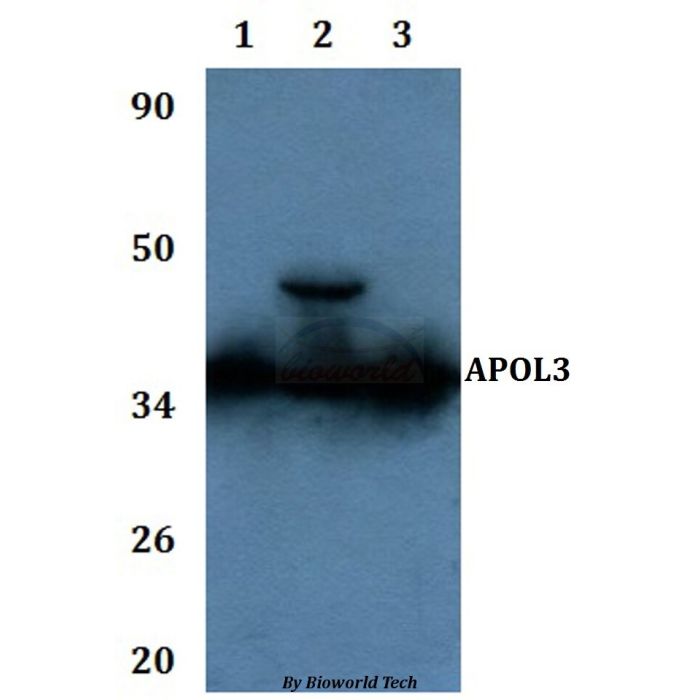APOL3 polyclonal, anti-human, mouse, rat
€305.00
In stock
SKU
BS61133
Background:
Apolipoproteins are protein components of plasma lipoproteins. The apolipoprotein L gene family encodes six highly homologous proteins designated apoL1-6, which are associated with large high density type lipoproteins (HDL). The human apoL family maps to chromosome 22q12.1-13.1 within a 127,000 bp region. apoL2 and apoL3 may allow the binding of lipids to organelles or may be involved in the movement of lipids in the cytoplasm. apoL2 localizes to the cytoplasm and is widely expressed, with the highest levels observed in the lung, thymus, pancreas, placenta, adult brain and prostate. The apoL2 protein is also detected in the spleen, liver, kidney, colon, small intestine, uterus, spinal cord, adrenal gland, salivary gland, trachea, mammary gland, skeletal muscle, testis and fetal brain and liver. apoL3 also localizes to the cytoplasm and is widely expressed, with highest levels detected in the prostate, lung and placenta. It is also detected in kidney, bone marrow, spleen, thymus, spinal cord, adrenal gland, salivary gland, trachea and mammary gland. Lower levels of apoL3 are observed in the brain, heart, fetal liver, pancreas and testis.
Alternative Name:
Apolipoprotein L3, Apolipoprotein L-III, ApoL-III, TNF-inducible protein CG12-1, CG12_1
Application Dilution: WB: 1:500~1:1000
Specificity: APOL3 polyclonal antibody detects endogenous levels of APOL3 protein.
Immunogen:
A synthetic peptide corresponding to residues in Human APOL3.
MW: ~ 36, 44kDa
Swis Prot.: O95236
Purification & Purity:
The antibody was affinity-purified from rabbit antiserum by affinity-chromatography using epitope-specific immunogen and the purity is > 95% (by SDS-PAGE).
Format:
1 mg/ml in Phosphate buffered saline (PBS) with 0.05% sodium azide, approx. pH 7.3.
Storage:
Store at 4°C short term. Aliquot and store at -20°C long term. Avoid freeze-thaw cycles.
For research use only, not for use in diagnostic procedure.
Apolipoproteins are protein components of plasma lipoproteins. The apolipoprotein L gene family encodes six highly homologous proteins designated apoL1-6, which are associated with large high density type lipoproteins (HDL). The human apoL family maps to chromosome 22q12.1-13.1 within a 127,000 bp region. apoL2 and apoL3 may allow the binding of lipids to organelles or may be involved in the movement of lipids in the cytoplasm. apoL2 localizes to the cytoplasm and is widely expressed, with the highest levels observed in the lung, thymus, pancreas, placenta, adult brain and prostate. The apoL2 protein is also detected in the spleen, liver, kidney, colon, small intestine, uterus, spinal cord, adrenal gland, salivary gland, trachea, mammary gland, skeletal muscle, testis and fetal brain and liver. apoL3 also localizes to the cytoplasm and is widely expressed, with highest levels detected in the prostate, lung and placenta. It is also detected in kidney, bone marrow, spleen, thymus, spinal cord, adrenal gland, salivary gland, trachea and mammary gland. Lower levels of apoL3 are observed in the brain, heart, fetal liver, pancreas and testis.
Alternative Name:
Apolipoprotein L3, Apolipoprotein L-III, ApoL-III, TNF-inducible protein CG12-1, CG12_1
Application Dilution: WB: 1:500~1:1000
Specificity: APOL3 polyclonal antibody detects endogenous levels of APOL3 protein.
Immunogen:
A synthetic peptide corresponding to residues in Human APOL3.
MW: ~ 36, 44kDa
Swis Prot.: O95236
Purification & Purity:
The antibody was affinity-purified from rabbit antiserum by affinity-chromatography using epitope-specific immunogen and the purity is > 95% (by SDS-PAGE).
Format:
1 mg/ml in Phosphate buffered saline (PBS) with 0.05% sodium azide, approx. pH 7.3.
Storage:
Store at 4°C short term. Aliquot and store at -20°C long term. Avoid freeze-thaw cycles.
For research use only, not for use in diagnostic procedure.
| Is Featured? | No |
|---|
Write Your Own Review

